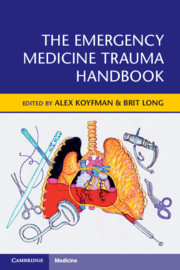42 results
Chapter 1 - Legislating in Accordance with Nature in Plato’s Laws
- from Part I - Humans in Nature: Nature and Law, Humans and Natural Catastrophes
-
-
- Book:
- Ancient Ethics and the Natural World
- Published online:
- 13 August 2021
- Print publication:
- 12 August 2021, pp 15-31
-
- Chapter
- Export citation
Lower neck organs at risk sparing in nasopharyngeal carcinoma using hybrid volumetric-modulated arc therapy (hybrid-VMAT): a case report
-
- Journal:
- Journal of Radiotherapy in Practice / Volume 21 / Issue 3 / September 2022
- Published online by Cambridge University Press:
- 23 April 2021, pp. 434-445
-
- Article
-
- You have access
- Open access
- HTML
- Export citation
Just the Facts: Ovarian torsion in the emergency department setting
-
- Journal:
- Canadian Journal of Emergency Medicine / Volume 22 / Issue 6 / November 2020
- Published online by Cambridge University Press:
- 11 September 2020, pp. 756-759
- Print publication:
- November 2020
-
- Article
-
- You have access
- HTML
- Export citation
Just the Facts: Diagnosis and management of small bowel obstruction
-
- Journal:
- Canadian Journal of Emergency Medicine / Volume 22 / Issue 5 / September 2020
- Published online by Cambridge University Press:
- 22 June 2020, pp. 648-651
- Print publication:
- September 2020
-
- Article
-
- You have access
- HTML
- Export citation
Just the Facts: Diagnosis and management of rhabdomyolysis
-
- Journal:
- Canadian Journal of Emergency Medicine / Volume 22 / Issue 6 / November 2020
- Published online by Cambridge University Press:
- 11 May 2020, pp. 745-748
- Print publication:
- November 2020
-
- Article
-
- You have access
- HTML
- Export citation
Contributors
-
- Book:
- The Emergency Medicine Trauma Handbook
- Published online:
- 23 August 2019
- Print publication:
- 17 October 2019, pp vi-viii
-
- Chapter
- Export citation
Preface
-
- Book:
- The Emergency Medicine Trauma Handbook
- Published online:
- 23 August 2019
- Print publication:
- 17 October 2019, pp ix-ix
-
- Chapter
- Export citation
Disclaimer
-
- Book:
- The Emergency Medicine Trauma Handbook
- Published online:
- 23 August 2019
- Print publication:
- 17 October 2019, pp x-x
-
- Chapter
- Export citation
Contents
-
- Book:
- The Emergency Medicine Trauma Handbook
- Published online:
- 23 August 2019
- Print publication:
- 17 October 2019, pp v-v
-
- Chapter
- Export citation
Index
-
- Book:
- The Emergency Medicine Trauma Handbook
- Published online:
- 23 August 2019
- Print publication:
- 17 October 2019, pp 347-358
-
- Chapter
- Export citation
Copyright page
-
- Book:
- The Emergency Medicine Trauma Handbook
- Published online:
- 23 August 2019
- Print publication:
- 17 October 2019, pp iv-iv
-
- Chapter
- Export citation

The Emergency Medicine Trauma Handbook
-
- Published online:
- 23 August 2019
- Print publication:
- 17 October 2019
Chapter 3 - Socratic Discussions of Death and Immortality in Plato
-
-
- Book:
- Authors and Authorities in Ancient Philosophy
- Published online:
- 07 September 2018
- Print publication:
- 13 September 2018, pp 58-77
-
- Chapter
- Export citation
(C.S.) O'Brien The Demiurge in Ancient Thought: Secondary Gods and Divine Mediators. Cambridge: Cambridge University Press, 2015. Pp. xvi + 333. £65./$99. 9781107075368.
-
- Journal:
- The Journal of Hellenic Studies / Volume 136 / 2016
- Published online by Cambridge University Press:
- 07 October 2016, pp. 280-281
- Print publication:
- 2016
-
- Article
- Export citation
A Successful Vancomycin-Resistant Enterococci Reduction Bundle at a Singapore Hospital
-
- Journal:
- Infection Control & Hospital Epidemiology / Volume 37 / Issue 1 / January 2016
- Published online by Cambridge University Press:
- 21 October 2015, pp. 107-109
- Print publication:
- January 2016
-
- Article
- Export citation
PLATO AND HIS READERS - A.K. Cotton Platonic Dialogue and the Education of the Reader. Pp. x + 330. Oxford: Oxford University Press, 2014. Cased, £70, US$125. ISBN: 978-0-19-968405-2.
-
- Journal:
- The Classical Review / Volume 65 / Issue 1 / April 2015
- Published online by Cambridge University Press:
- 11 December 2014, pp. 49-51
- Print publication:
- April 2015
-
- Article
- Export citation
ESSAYS IN HONOUR OF CHRISTOPHER ROWE - (G.) Boys-Stones, (D.) El Murr, (C.) Gill (edd.) The Platonic Art of Philosophy. Pp. x + 341. Cambridge: Cambridge University Press, 2013. Cased, £65, US$99. ISBN: 978-1-107-03898-1.
-
- Journal:
- The Classical Review / Volume 64 / Issue 2 / October 2014
- Published online by Cambridge University Press:
- 25 June 2014, pp. 393-395
- Print publication:
- October 2014
-
- Article
- Export citation
Stoic Cosmology And Theology - (R.) Salles (ed.) God and Cosmos in Stoicism. Pp. x + 274. Oxford: Oxford University Press, 2009. Cased, £45, US$85. ISBN: 978-0-19-955614-4.
-
- Journal:
- The Classical Review / Volume 62 / Issue 2 / October 2012
- Published online by Cambridge University Press:
- 12 September 2012, pp. 425-426
- Print publication:
- October 2012
-
- Article
- Export citation
Rotating wall vessel exposure alters protein secretion and global gene expression in Staphylococcus aureus
-
- Journal:
- International Journal of Astrobiology / Volume 11 / Issue 2 / April 2012
- Published online by Cambridge University Press:
- 05 December 2011, pp. 71-81
-
- Article
- Export citation
Contents
-
- Book:
- Plato: Meno and Phaedo
- Published online:
- 05 June 2014
- Print publication:
- 25 November 2010, pp v-vi
-
- Chapter
- Export citation



